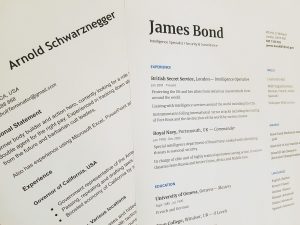Are you Resume Ready?


Resume Review - Remote
Effective Resume Strategy Recommendations from the 24/7s
- A two-page maximum and strive to make it compliant with the Applicant Tracking System technology and guidelines.
- Use a “chronological” resume, not a “functional” resume.
- Strategically prioritize your “space”, giving the most impressive and most marketable experiences, the most usage.
- Realize a resume is a “living document” and can/should be updated as you get reactions, suggestions and new experiences, but do not get overwhelmed by “resume-itis” and refrain from using it!
- Absolutely ZERO typos and grammatical errors and make sure it transmits and prints perfectly.
- Does the resume “match up” your skills and experiences to the job requirements? If not, modify the resume to fit each posting .
- Be able to explain and defend every accomplishment, word and term when asked by a interviewer and give examples.
- Is this a document you’re proud of ? Does it create a “competitive advantage” for you as a candidate in your search.
- Does your resume cause prospective employers to say “WOW” – I can’t wait to get this person in for an interview.
What Does Your Email Say?
Your email may make a difference as you submit your job application. Some email domains won’t die — netscape.net, hotmail.com, juno.com, excite.com, me.com — and so on.
One of our 24x7s told the story of some corporate managers who excluded applicants other than those with Gmail or Outlook accounts. They perceived the applicants with the other email domains to be less tech savvy. Notice, neither AOL nor Yahoo was in the acceptable pile either.
A professional email address is vital too: or may raise an eyebrow.
It’s advisable to create an email address just for job search. You’ll have one place to look for application responses and your job alerts. Try to just use your name, mix a middle initial, maybe a degree or certification if necessary to get an address you’d prefer.

Applicant

Tracking

System
Applicant tracking systems are the computer systems used by organizations to manage the flood of applications they receive. The ATS will read your resume, and then rank and score your qualifications vs. the job descriptions. Only those applicants who receive high scores will get a call for an interview. If you follow these formatting tips you will greatly increase the likelihood that your resume will rise to the top of the list.
Read Denis’s Tips Do not use templates! Use a standard Word document, and save in .doc format: File/Save As/Word 97-2003. Not all ATS systems can read .docx, PDF, RTF, and JPG formats. Use simple formatting. Do not use headers (including for contact information), footers, templates, borders, lines, symbols (bullet points are fine) or shading. Customize each resume for the specific position being sought using language from the job description. “One-size-fits-all” does not work with applicant tracking systems. Incorporate relevant, targeted keywords and phrases for the position being sought. Be specific — i.e. “Adobe Photoshop” instead of “image-editing software”). Use keywords and phrases in context. Incorporate them into descriptive achievement oriented bullet points; do not just include them as a list of skills or competencies. Edit carefully: The ATS will not recognize misspelled words. And, if your resume survives the ATS screening, it will next be reviewed by human beings so it must be error-free. Make sure your optimized resume also: Does not include any special characters or accented words. Includes no punctuation in your name, such as ( ) , / – Is in a single column format (no tables, multiple columns, or text boxes). Uses simply formatted text of a reasonable size (11 point font or above). Contains only your name on the top line, with no degrees or certifications after it. Includes standard fonts (Arial, Georgia, Tahoma, Calibri, and Verdana are safe choices) Arial is the preferred typeface. Includes dates on the right margin. Use a space dash space between years: 2005 – Present Does not use complex formatting (condensed or expanded text) – that is, don’t use extra spaces between letters, because the ATS can’t “read” it. Be sure to use proper capitalization and punctuation. Both of these can affect how information is parsed and assigned within the ATS database. Use the full, spelled-out version of terms in addition to abbreviations and acronyms [i.e. Certified Public Accountant (CPA)]. Do remember that even if you have a personal connection through your network, your resume will typically need to be submitted to the company’s ATS. When applying for a specific position, do use that exact job title on the resume. When listing dates for employment or education, do list dates to the right of the information. If you wish to include a context statement describing the organization you worked with, do include that statement after the organization name, your title, and employment dates. Do consider including section titles in ALL CAPS and centered to make it easy for the applicant tracking system to categorize the information. Include these section titles: CAREER SUMMARY PROFESSIONAL EXPERIENCE EDUCATION If you are working towards a certification that is a requirement for the position, do include it on the resume — but make sure you include a phrase such as “Pursuing (name of credential)” ‘Expected graduation in 2021.” Do check your email after applying for a position online. Some applicant tracking systems acknowledge submissions, but these automated responses may be diverted to your spam folder. If given the choice, do upload your resume rather than cutting and pasting sections into text boxes. When it is eventually forwarded to a human, it will look much more attractive. Do be mindful of special characters and accents you use on your resume. Some words and phrases can be misinterpreted by an applicant tracking system – for example, accented words. The word “résumé” itself is not ATS-friendly. The ATS does not recognize the accented letters. Instead, it reads it as “r?sum?.” Do feel free to make your resume as long as you want to. The ATS will not penalize you for length.. However, since it may also be read by a person, keeping it to two pages is smart. If you have a 2-page resume, put your name and Page 2 in a header so the ATS can’t “see” it. Try to maintain a margin on all sides of your resume of approximately three quarters of an inch or more. Don’t list your credentials (MBA, CPA, etc.) next to your name. Include that information on a separate line. Don’t include skills you don’t possess on the resume as an attempt to “trick” the applicant tracking system into selecting you. Anything on your resume needs to be substantiated in an interview, or increasingly in a skills-based test before you interview. Don’t mix different fonts and sizes in your resume. Don’t include pictures, graphics or logos in your resume. Don’t feel the need to create a completely stripped down document. In the old days we would save documents in .txt format with absolutely no formatting before submitting online. Because your resume will eventually be seen by a human being, keeping some simple formatting such as bold, caps and bullet points will help to keep your resume attractive. Don’t use underlines or italics as the ATS cannot read these.
